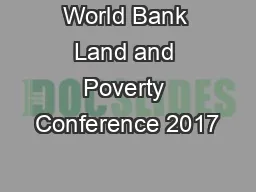

Achieving Land Degradation Neutrality For Improved Equity Sustainability And Resilience March 23 2017 By Melchiade Bukuru Chief of Office Definition of Land Degradation Neutral World Land Degradation Neutrality is a state whereby the amount and quality of land resources necessary to ID: 634432
Download Presentation The PPT/PDF document "World Bank Land and Poverty Conference 2..." is the property of its rightful owner. Permission is granted to download and print the materials on this web site for personal, non-commercial use only, and to display it on your personal computer provided you do not modify the materials and that you retain all copyright notices contained in the materials. By downloading content from our website, you accept the terms of this agreement.
Slide1
World Bank Land and Poverty Conference 2017
Achieving Land Degradation Neutrality For Improved Equity, Sustainability And Resilience
March 23, 2017
By
Melchiade
Bukuru
Chief of OfficeSlide2
Definition of Land Degradation Neutral World
Land Degradation Neutrality is a state whereby the amount and quality of land resources, necessary to support ecosystem functions and services and enhance food security, remains stable or increases within specified temporal and spatial scales and ecosystems.Slide3
This target would be achieved by
a) Managing land more sustainably, which would reduce the rate of degradation;
b) Increasing the rate of restoration of degraded land.The two trends would converge towards a state whereby the amount of healthy and productive land resources, necessary to support ecosystem services, remains stable or increases.Slide4
What Land Degradation Neutral World implies
In many countries, achieving land degradation neutrality will require a paradigm shift in land stewardship: from “degrade-abandon-move” (DAM) to “protect-sustain-restore”(PSR)
Slide5
(a) Adopting sustainable land management policies and practices in order to minimize current, and avoid future, land degradation and
(b) Rehabilitating degraded lands and abandoned production lands as well as restoring degraded natural and semi-natural ecosystems that provide vital benefit to people and working landscapes.Slide6
Setting LDN targets and associated measures
The LDN response hierarchy
1. Avoid
Many forms of land degradation can be avoided through proactive measures to confer resilience and prevent adverse change in the quality of non-degraded land via appropriate regulation, planning or activity design.Slide7
2. Reduce
Land degradation can be mitigated through reactive practical actions that reduce in situ impacts on land currently undergoing degrading use (e.g. sustainable land management).
As a planning principle, LDN involves making land-use decisions according to a response hierarchy that prioritizes the avoidance of land degradation: “Prevention is better than cure”. Slide8
3. Reverse
Where feasible, some (but rarely all) of the productive potential and ecological services of degraded land can be restored or rehabilitated through actively assisting the recovery of ecosystem functions.Slide9
For many developing countries, long-term food security and economic growth is highly dependent on the management of their land resources, including soil, water and biodiversity. To ensure the sustainable use of these essential components into the future, there is no choice but to support a new vision of stewardship based on
rights, rewards and responsibilities.
Slide10
The UNCCD is supporting over 100 countries to integrate appropriate land governance systems in their voluntary land degradation neutrality targets. The UNCCD’s new flagship publication, the Global Land Outlook, strongly advocates for national and local governments to play a critical role in developing the necessary governance and incentive frameworks that encourage more sustainable land management decisions at all scales.
Otherwise, future scenarios are rife with shortages, conflicts and instability.Slide11
Take Away Message
Achieving land degradation neutrality will contribute to:
Improving equity, sustainability and resilience;
Land tenure policies are keys to address land degradation (when you don’t own you don’t care);As much as land tenure is central to our discussion, the health of that land matters; Since the map of poverty coincides with that of degraded lands, it’s crucial that our annual meeting pay the same level of attention to land degradation.